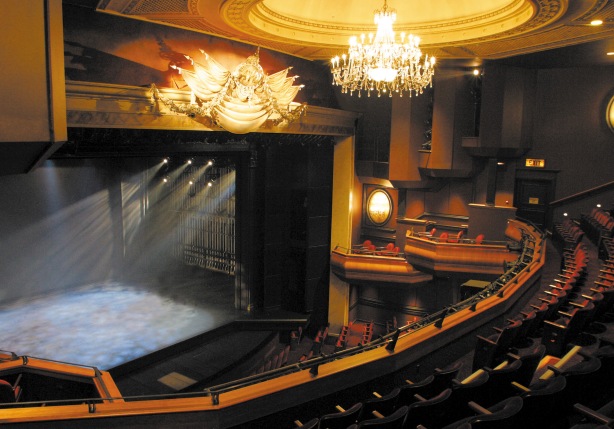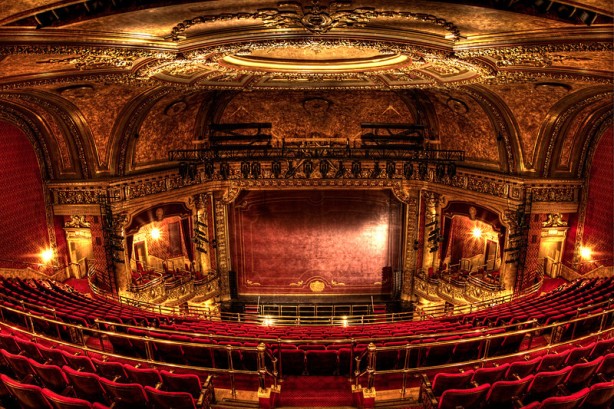 The debate over David Mirvish’s plans to tear down the Princess of Wales Theatre and build three Frank Gehry-designed condo towers rages on. Well, not exactly raging. In fact, there seems to be more concern over the Edwardian-era warehouse-turned-offices that surround the theatre than there is over the state-of-the-art venue itself. Not surprising, considering this is Toronto.
The debate over David Mirvish’s plans to tear down the Princess of Wales Theatre and build three Frank Gehry-designed condo towers rages on. Well, not exactly raging. In fact, there seems to be more concern over the Edwardian-era warehouse-turned-offices that surround the theatre than there is over the state-of-the-art venue itself. Not surprising, considering this is Toronto.
Let me recap: In 2008, Dancap Productions entered into an agreement with Key Brand Entertainment to lease the Canon Theatre (formally the Pantages, now the Ed Mirvish) and the Panasonic Theatre after Mirvish allowed their leases to expire. Shortly after the announcement, the properties were sold to Mirvish, effectively cancelling Dancap’s lease and all but locking them out of the vital downtown Entertainment District. Less than five years later, Dancap is out of business and David Mirvish declares that Toronto has too many large theatres so he’ll be tearing down the much-loved Princess of Wales, less than 20 years old, to build three Frank Gehry-designed condo towers when the city already has an oversupply. I wrote a more detailed account of the events here if you haven’t already read it.
Now, there’s been a lot of praise for Gehry’s design of the proposed towers and there’s also been a lot of scorn. The designs are bold and artistic, and the aesthetic merits of the buildings or their effect on Toronto’s skyline is open to interpretation (beauty in the eye of the beholder and all that) and is not where my concern is. My concern doesn’t even lie with the potential loss of the historic warehouse buildings along King Street. My concern lies solely with the Princess of Wales Theatre, and I seem to be the only one.
What people fail to realize is that losing the Princess of Wales means losing money from the city’s economy every year, money that new condos won’t replace. Theatre is the number one reason tourists travel to Toronto, according to the City of Toronto itself (page 4 of this document). A hit production such as Wicked or the currently-running Les Miserables can pump between $600-$800 million a year into the city’s economy primarily through tourism, not to mention 2000 jobs. All of that is apparently unneeded in Toronto. Or maybe we just want extra condos that much more. The Princess of Wales could have easily been included in the plans for the new towers or at least a similarly-sized replacement venue. Toronto-born Gehry, however, wanted a clean slate and doesn’t really believe in the historical preservation of buildings… unless they have something to do with him. And let’s be realistic here: we barely know what Toronto would be getting from these condos beyond it’s exterior design and stature. Mirvish is trying to sell the city on a few images alone, hoping they’re flashy enough to make city planners lose all foresight and reason and approve them without knowing all of the details. Trying to sell the project as an icon for the city only speaks to Mirvish’s motivations: creating his own legacy. A legacy that, by tearing down the Princess of Wales and selling Honest Ed’s to finance it, will come at the expense of his father’s (and doesn’t understand why Torontonians aren’t more appreciative to what he’s trying to do). As this article brilliantly summed it up, “…the real irony is if we truly want to build an icon for the city why are we destroying the iconic Princess of Wales Theatre in the process? That is what should be the Mirvish’s real heritage and legacy, for while it many not be braggy in its own exterior form, it is a place of great cultural value.” Great financial value too.
Toronto needs more large-scale theatre, not less. We need smarter programming to fill the theatres and better marketing to promote them. We need commercial theatre tax credits to lure more producers to Toronto with their productions and the tourist spending that come with them. I’m the first to admit that Toronto needs more architectural interest beyond the common glass towers that are quickly rising from the streets, but tearing down the city’s best and only barrier-free large theatre to build condos isn’t the way to do it.




